Page 277 of 416
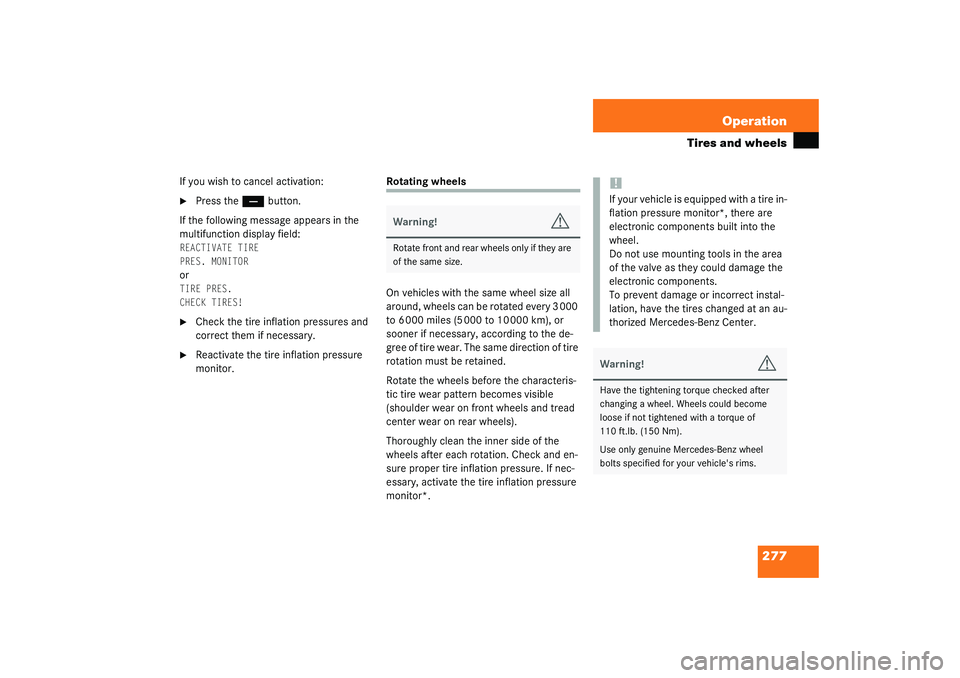
277 Operation
Tires and wheels
If you wish to cancel activation:�
Press the
ç
button.
If the following message appears in the
multifunction display field:
REACTIVATE TIRE
PRES. MONITOR
or
TIRE PRES.
CHECK TIRES!
�
Check the tire inflation pressures and
correct them if necessary.
�
Reactivate the tire inflation pressure
monitor.
Rotating wheels
On vehicles with the same wheel size all
around, wheels can be rotated every 3 000
to 6 000 miles (5 000 to 10 000 km), or
sooner if necessary, according to the de-
gree of tire wear. The same direction of tire
rotation must be retained.
Rotate the wheels before the characteris-
tic tire wear pattern becomes visible
(shoulder wear on front wheels and tread
center wear on rear wheels).
Thoroughly clean the inner side of the
wheels after each rotation. Check and en-
sure proper tire inflation pressure. If nec-
essary, activate the tire inflation pressure
monitor*.Warning!
G
Rotate front and rear wheels only if they are
of the same size.
!If your vehicle is equipped with a tire in-
flation pressure monitor*, there are
electronic components built into the
wheel.
Do not use mounting tools in the area
of the valve as they could damage the
electronic components.
To prevent damage or incorrect instal-
lation, have the tires changed at an au-
thorized Mercedes-Benz Center.Warning!
G
Have the tightening torque checked after
changing a wheel. Wheels could become
loose if not tightened with a torque of
110 ft.lb. (150 Nm).
Use only genuine Mercedes-Benz wheel
bolts specified for your vehicle's rims.
Page 289 of 416
289 Practical hints
What to do if …?
Where will I find ...?
Unlocking/locking in an emergency
Opening/closing in an emergency
Replacing bulbs
Replacing wiper blades
Flat tire
Battery
Jump starting
Towing the vehicle
Fuses
Page 316 of 416
316 Practical hintsWhat to do if …?<
SEAT BELT SYSTEM
VISIT WORKSHOP!
The seat belt system is malfunctioning.
�
Visit an authorized Mercedes-Benz
Center as soon as possible.
H
TIRE PRES. MONITOR
PRES. DISPLAY AFTER
DRIVING A FEW MINS. RE-
ACTIVATE USING R BUTTON
The tire pressure is being checked.
TIRE PRES. MONITOR
REACTIVATE!
The tire inflation pressure monitor* is de-
activated.
�
Activate the tire inflation pressure moni-
tor* (
�page 276).
Display
Possible cause
Suggested solution
Warning!
G
Do not drive with a flat tire. A flat tire affects
the ability to steer or brake the vehicle.
You may lose control of the vehicle. Contin-
ued driving with a flat tire will cause exces-
sive heat build-up and possibly a fire.
Page 317 of 416
317 Practical hints
What to do if …?
Display
Possible cause
Suggested solution
H
TIRE PRES. MONITOR
NOT ACTIVE
The tire inflation pressure monitor* is un-
able to monitor the tire pressure due to�
the presence of several wheel sensors
in the vehicle.
�
excessive wheel sensor temperatures.
�
a nearby radio interference source.
�
unrecognized wheel sensors mounted.
�
Check the tire pressure at the next ser-
vice station.
TIRE PRES. MONITOR
VISIT WORKSHOP!
The tire inflation pressure monitor* is mal-
functioning.
�
Have the tire inflation pressure monitor*
checked by an authorized Mercedes-Benz
Center.
�
Change the wheel (
�page 339).
A wheel without proper sensor was in-
stalled.
�
Check and correct tire pressure as re-
quired (
�page 273).
Warning!
G
Do not drive with a flat tire. A flat tire affects
the ability to steer or brake the vehicle.
You may lose control of the vehicle. Contin-
ued driving with a flat tire will cause exces-
sive heat build-up and possibly a fire.
Page 318 of 416
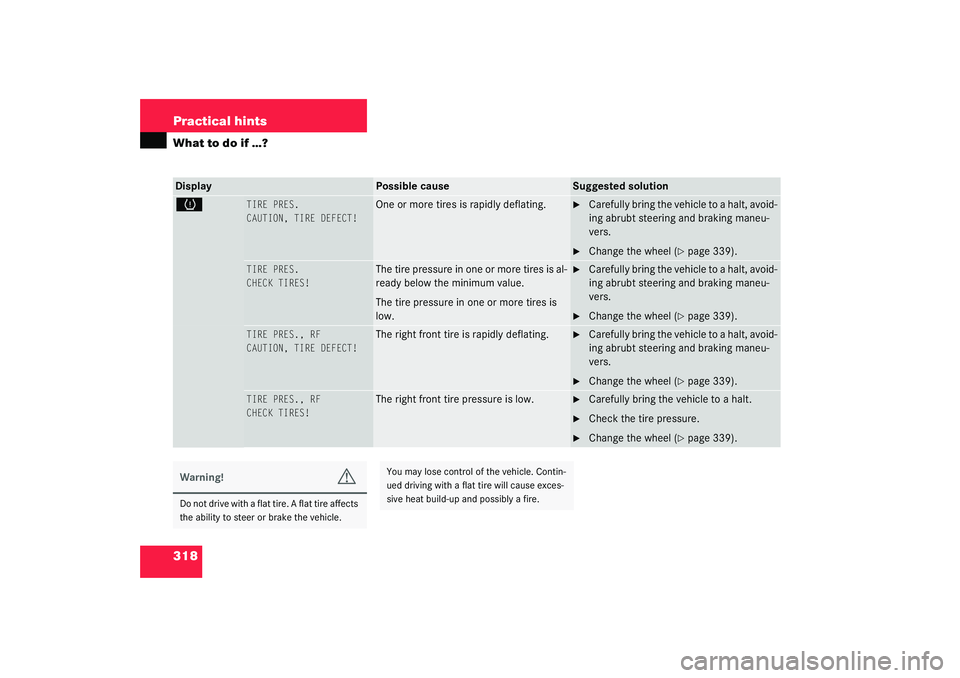
318 Practical hintsWhat to do if …?Display
Possible cause
Suggested solution
H
TIRE PRES.
CAUTION, TIRE DEFECT!
One or more tires is rapidly deflating.
�
Carefully bring the vehicle to a halt, avoid-
ing abrubt steering and braking maneu-
vers.
�
Change the wheel (
�page 339).
TIRE PRES.
CHECK TIRES!
The tire pressure in one or more tires is al-
ready below the minimum value.
The tire pressure in one or more tires is
low.
�
Carefully bring the vehicle to a halt, avoid-
ing abrubt steering and braking maneu-
vers.
�
Change the wheel (
�page 339).
TIRE PRES., RF
CAUTION, TIRE DEFECT!
The right front tire is rapidly deflating.
�
Carefully bring the vehicle to a halt, avoid-
ing abrubt steering and braking maneu-
vers.
�
Change the wheel (
�page 339).
TIRE PRES., RF
CHECK TIRES!
The right front tire pressure is low.
�
Carefully bring the vehicle to a halt.
�
Check the tire pressure.
�
Change the wheel (
�page 339).
Warning!
G
Do not drive with a flat tire. A flat tire affects
the ability to steer or brake the vehicle.
You may lose control of the vehicle. Contin-
ued driving with a flat tire will cause exces-
sive heat build-up and possibly a fire.
Page 319 of 416
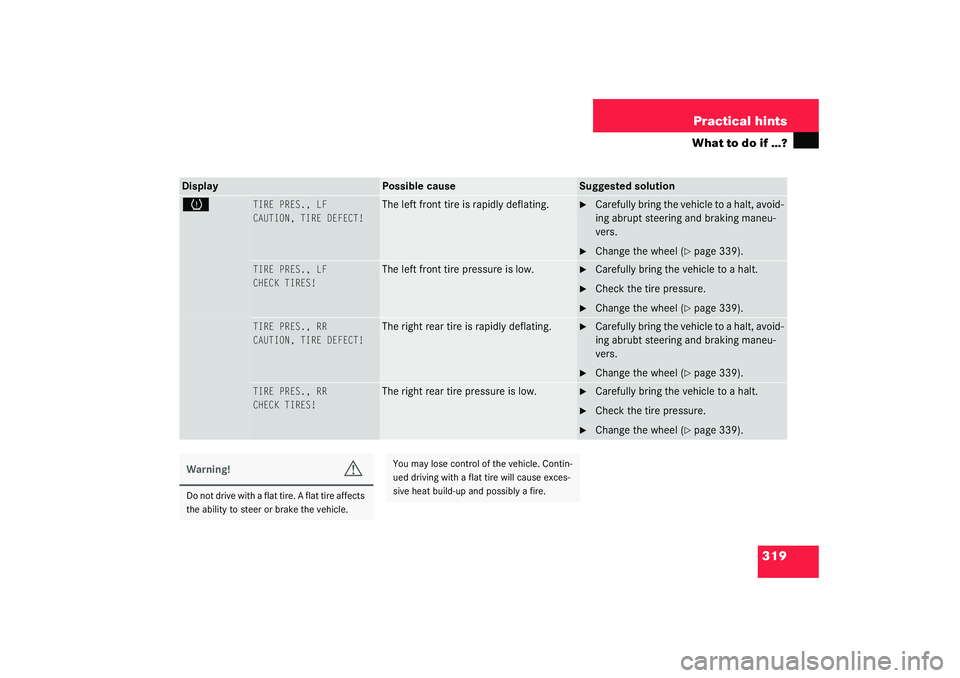
319 Practical hints
What to do if …?
Display
Possible cause
Suggested solution
H
TIRE PRES., LF
CAUTION, TIRE DEFECT!
The left front tire is rapidly deflating.
�
Carefully bring the vehicle to a halt, avoid-
ing abrupt steering and braking maneu-
vers.
�
Change the wheel (
�page 339).
TIRE PRES., LF
CHECK TIRES!
The left front tire pressure is low.
�
Carefully bring the vehicle to a halt.
�
Check the tire pressure.
�
Change the wheel (
�page 339).
TIRE PRES., RR
CAUTION, TIRE DEFECT!
The right rear tire is rapidly deflating.
�
Carefully bring the vehicle to a halt, avoid-
ing abrubt steering and braking maneu-
vers.
�
Change the wheel (
�page 339).
TIRE PRES., RR
CHECK TIRES!
The right rear tire pressure is low.
�
Carefully bring the vehicle to a halt.
�
Check the tire pressure.
�
Change the wheel (
�page 339).
Warning!
G
Do not drive with a flat tire. A flat tire affects
the ability to steer or brake the vehicle.
You may lose control of the vehicle. Contin-
ued driving with a flat tire will cause exces-
sive heat build-up and possibly a fire.
Page 320 of 416
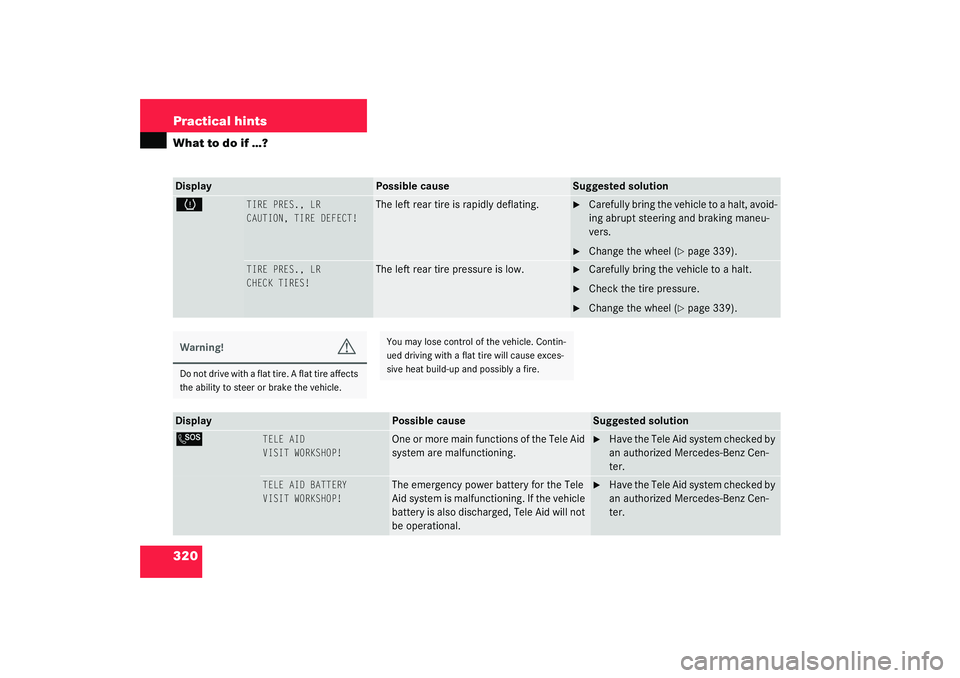
320 Practical hintsWhat to do if …?Display
Possible cause
Suggested solution
H
TIRE PRES., LR
CAUTION, TIRE DEFECT!
The left rear tire is rapidly deflating.
�
Carefully bring the vehicle to a halt, avoid-
ing abrupt steering and braking maneu-
vers.
�
Change the wheel (
�page 339).
TIRE PRES., LR
CHECK TIRES!
The left rear tire pressure is low.
�
Carefully bring the vehicle to a halt.
�
Check the tire pressure.
�
Change the wheel (
�page 339).
Warning!
G
Do not drive with a flat tire. A flat tire affects
the ability to steer or brake the vehicle.
You may lose control of the vehicle. Contin-
ued driving with a flat tire will cause exces-
sive heat build-up and possibly a fire.
Display
Possible cause
Suggested solution
L
TELE AID
VISIT WORKSHOP!
One or more main functions of the Tele Aid
system are malfunctioning.
�
Have the Tele Aid system checked by
an authorized Mercedes-Benz Cen-
ter.
TELE AID BATTERY
VISIT WORKSHOP!
The emergency power battery for the Tele
Aid system is malfunctioning. If the vehicle
battery is also discharged, Tele Aid will not
be operational.
�
Have the Tele Aid system checked by
an authorized Mercedes-Benz Cen-
ter.
Page 324 of 416
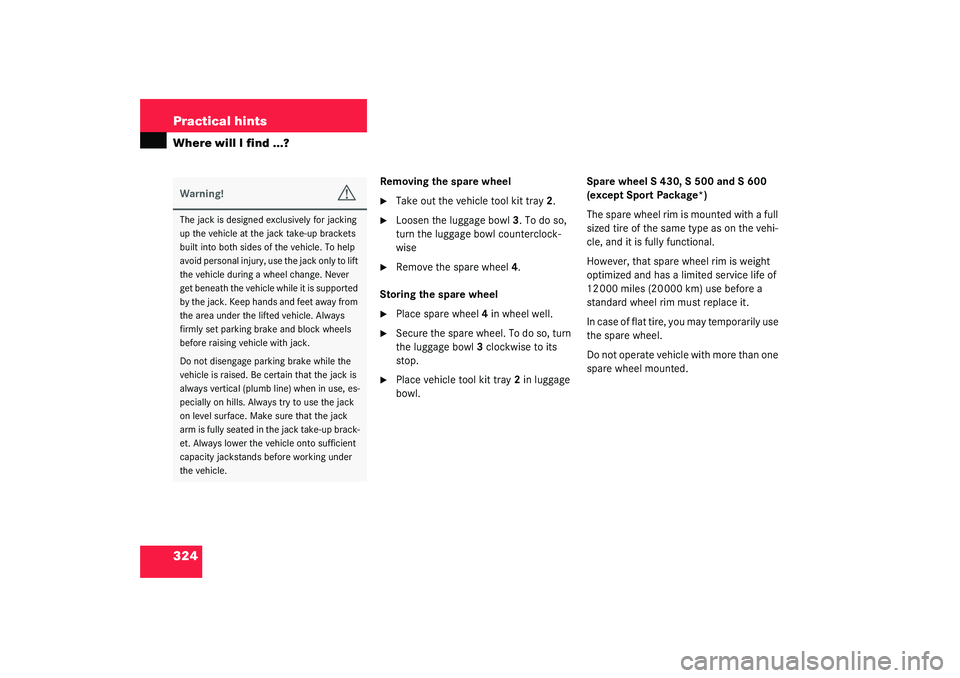
324 Practical hintsWhere will I find ...?
Removing the spare wheel�
Take out the vehicle tool kit tray2.
�
Loosen the luggage bowl3. To do so,
turn the luggage bowl counterclock-
wise
�
Remove the spare wheel4.
Storing the spare wheel
�
Place spare wheel4 in wheel well.
�
Secure the spare wheel. To do so, turn
the luggage bowl3 clockwise to its
stop.
�
Place vehicle tool kit tray2 in luggage
bowl.Spare wheel S 430, S 500 and S 600
(except Sport Package*)
The spare wheel rim is mounted with a full
sized tire of the same type as on the vehi-
cle, and it is fully functional.
However, that spare wheel rim is weight
optimized and has a limited service life of
12 000 miles (20 000 km) use before a
standard wheel rim must replace it.
In case of flat tire, you may temporarily use
the spare wheel.
Do not operate vehicle with more than one
spare wheel mounted.
Warning!
G
The jack is designed exclusively for jacking
up the vehicle at the jack take-up brackets
built into both sides of the vehicle. To help
avoid personal injury, use the jack only to lift
the vehicle during a wheel change. Never
get beneath the vehicle while it is supported
by the jack. Keep hands and feet away from
the area under the lifted vehicle. Always
firmly set parking brake and block wheels
before raising vehicle with jack.
Do not disengage parking brake while the
vehicle is raised. Be certain that the jack is
always vertical (plumb line) when in use, es-
pecially on hills. Always try to use the jack
on level surface. Make sure that the jack
arm is fully seated in the jack take-up brack-
et. Always lower the vehicle onto sufficient
capacity jackstands before working under
the vehicle.